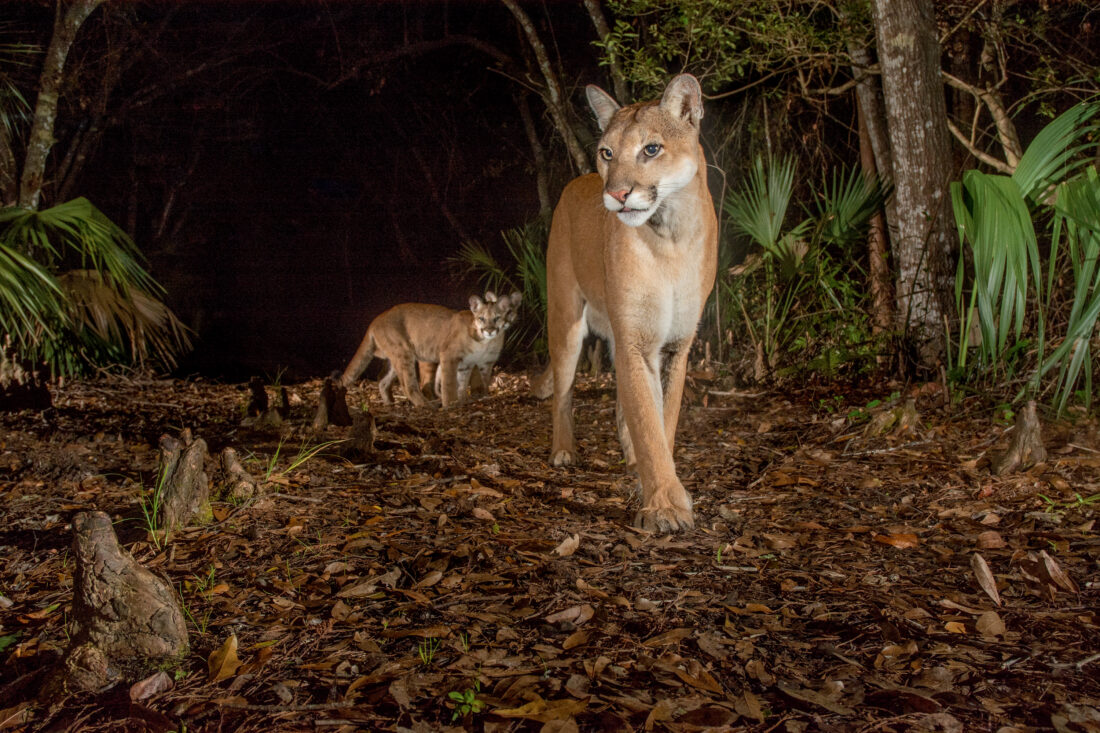Cattle ranchers are joining forces with conservation groups to support the big cat’s comeback.
August/September 2024

Someone once told the sixth-generation cattle rancher Jim Strickland a maxim that stuck with him: If you save the Florida panther, you save Florida. The endangered species, which represents the only breeding population of a big cat east of the Mississippi River, requires vast tracts to roam. Protecting it therefore ripples out to those ecosystems and other species, from butterflies and tree snails to alligators and black bears. Funnily enough, the panther now has a surprising ally in its comeback: ranchers like Strickland.
Once, all of Florida and beyond provided panther habitat. But a state bounty in the late nineteenth century, largely to protect livestock, paid out five dollars per pelt, and by the 1950s, the cat’s numbers had sunk perilously low. Up against the state’s rapid development, the panthers edged toward extinction before a last-ditch introduction of eight of them from Texas in the mid-1990s pulled them back. Since then, the resilient cat has clawed its way upward to two hundred or so individuals, concentrated in Southwest Florida. For that number to grow, they need more space.
That’s where large private landowners come in. As vice chairman of the Florida Conservation Group—a consortium of scientists, ranchers, and conservation and policy experts—Strickland acts as liaison, helping those running timber or cattle operations enter into win-win conservation easements. In a time when it can be tempting (and lucrative) to sell to developers, landowners can instead sell their development rights to conservation groups while keeping the land. “As ranchers, we just want to be able to pay our bills and stay sustainable,” Strickland explains. “The crux of the whole deal is that we get to retain ownership.”
Every little bit of land helps. “Some ranches have great swaths of habitat, with forested areas of pines and oaks, cover, palmetto patches, and hammocks,” says Dave Onorato, a panther biologist with the Florida Fish and Wildlife Conservation Commission (FWC). “Even though every one might not be a pristine, huge wilderness area, it’s still much better than that same patch of land becoming the next apartment complex.”
Onorato and the FWC, along with other agencies and partners, work year-round with the panthers, monitoring births, deaths, and genetic diversity; researching a relatively new disorder called feline leukomyelopa-thy, which affects mobility; responding to car strikes; tracking cats via collars; and setting up camera traps. In 2017, one of those cameras documented a panther with kittens that had done what no other female had in decades: crossed the Caloosahatchee River. The waterway near Fort Myers serves as the northern barrier to establishing a second breeding population, a key to long-term recovery. While male panthers will range hundreds of miles in search of a mate, females usually establish territory just outside of their mother’s, making their presence across the river a hopeful sign.
Since then, more females have followed, helping set the stage for a program that debuted last spring. The three-year pilot, funded by a $1.5 million grant from the National Fish and Wildlife Foundation, offers landowners financial incentives to make large tracts of land panther-friendly—plus money to offset livestock fatalities. “Embracing the fact that panthers live on our land means embracing the fact that they harvest their food on our land,” Strickland says. “We have to compensate those furnishing that food.” Earlier programs paid out per kill, putting the onus on ranchers to prove a panther was responsible. The new program, operated by the Fish & Wildlife Foundation of Florida and the FWC, will also pay by the acre of habitat provided. “I am hopeful this valuing of natural capital is going to move the needle with ranchers,” Strickland says.
Onorato, too, is optimistic. “The fact that the panthers are expanding on their own is such a great sign,” he says. Even so, most people will never spot the elusive cat in the wild. In his sixty-eight years, Strickland has seen only one. “A male panther ran in front of me, and I just sat in wonderment,” he recalls. “We have to treasure what we have and think about what we want this state to look like in a hundred years. That’s why I call myself a cowboy conservationist.”
